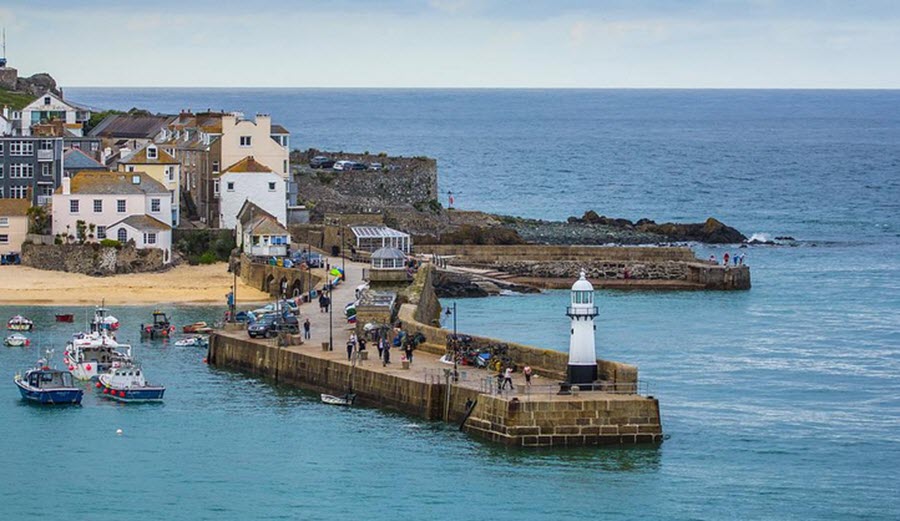This article is about the seaside town St. Ives in Penwith, in south-western Cornwall. It is not about the village St. Ive (without the “s”) in south-eastern Cornwall.
The port town of St. Ives in Cornwall has been a well-visited holiday destination ever since the opening of the St Ives Bay Line in 1877 made it possible to travel here by railway. Today, tourism is very important for the economy, but historically St. Ives was a fishing community. In the medieval era, it was even one of the most important fishing ports in all of northern Cornwall.
The town is located on the western shore of St Ives Bay, and the harbour is protected by Smeaton´s Pier and a headland called St Ives Island. The oldest part of town is the neighbourhood down by the harbour, where the streets are still narrow and uneven.
The railway brought in holidaymakers from far and wide, and many of the current buildings in St. Ives were constructed during the latter part of the 1800s to accommodate for this influx. St. Ives is no longer a major fishing port, but the harbour is still in use – chiefly for recreational boating. Day trips to nearby seal colonies are especially popular.
In the 21st century, “jumbo boats” – a class of Victorian fishing boats unique to St Ive’s – have been replicated by the boatbuilder Jonny Nance to highlight the town´s fishing heritage. They are operated by the St Ives Jumbo Association.

Name
The Cornish name for this town is Porth Ia, which means Cove of Ia. Saint Ia is the patron saint of the town.
Location
St. Ives is north of Penzance and west of Camborne, on Cornwall’s Celtic Sea coast.
Coordinates: 50.211°N 5.480°W
OS grid reference: SW518403
Postcode district: TR26
Tourism
Tourists spend circa £85 million per year in St. Ives, and in 2020 St. Ives was named the most expensive seaside resort in the United Kingdom.
In an average year, St. Ives is visited by around 220,000 staying tourists and 540,000 day trippers.
The tourism-industry accounts for circa 2,800 jobs in the area.
Beaches
- Porthminster, with nearly half-a-mile of sand. Close to the railway station.
- Porthmeor, chiefly known for its surfing. Firm sand.
- Porthgwidden, a small sandy cove
- Harbour, by the port
Walking
The famous South West Coast Path passes through St. Ives.
Climate
St. Ives has a temperate oceanic climate influenced by the Gulf Stream. Just like other parts of coastal Cornwall, it is renowned for having mild winters and sunny summers. The number of sunshine hours in an average year here is well above the national average.
St Ives Lifeboat Station
There has been a lifeboat stationed in St Ives ever since 1840, and a lifeboat house was erected at Porthgwidden by the Royal Nationa Lifeboat Institution (RNLI) in 1867. This site proved inoptimal for launchings, and was replaced with a building in Fore Street. In 1911, a new boathouse was built in Quay, followed by a larger station by West Pier in 1993.
Art
The Barbara Hepworth Museum and Sculpture Garden
A display of sculptures in bronze, stone and wood.
Dame Jocelyn Barbara Hepworth DBE (1903 – 1975) was a leading figure the colony of artists who resided in St Ives during the Second World War.
New Millennium Gallery
A collection of modern fine art and ceramics.
Tate St Ives
This is a branch of the famous Tate Gallery. Only open March – October. Tate St Ives is specialising in Cornish art.
Wills Lane Gallery
Works by local artists are for sale in this gallery, including paintings and sculptures.
History of St Ives
Saint Ia of Cornwall
According to legend, the Irish missionary Ia arrived to this place in the 5 th century. She is said to have been martyred under King Teudar (Tewdwr Mawr of Penwith). A church was built on top of her grave, and the town developed around it.
The Sloop Inn
Dated to circa 1312, The Sloop Inn is one of the oldest inns in Cornwall. It lies on the wharf in St. Ives.
The pier
We do not know when a pier was first constructed in St. Ives, but the oldest surviving reference to there being one in St. Ives is from 1478 when it is mentioned in one of William Worcester´s “Itineraries”. After falling into disrepair, the pier was re-built by John Smeaton in 1766-1770 and that is why we today call it Smeaton´s Pier. Later, it was made longer than the 18 th century design.
The Spanish Armada
In 1597, when the storm had dispersed the Spanish fleet, two of the ships – a bark and a pinnace – sought shelter in St. Ives. They were captured by the English warship Warspite, and the information learned from those onboard helped the English understand the Armada´s objectives.
Pedn Olva Mine
There used to be a copper mine in St Ives; the Pedn Olva Mine at Pedn Olva Point. It was active until 1911. Today, Pedn Olva Hotel is located on this site.